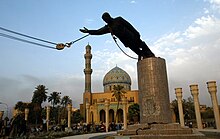
Back إسقاط تمثال صدام في ساحة الفردوس Arabic ھێنانەخوارەوەی پەیکەری سەددام لە گۆڕەپانی فیردەوس CKB سرنگونی مجسمه صدام حسین Persian Destruction de la statue du Square Firdos French הריסת פסלו של סדאם חוסיין HE Destruição da estátua da Praça Firdos Portuguese Firdevs Meydanı Olayı Turkish

| ||
|---|---|---|
|
Political offices
Rise to power Presidency Desposition Elections and referendums  |
||
On April 9, 2003, during the U.S. invasion of Iraq, a large statue of Saddam Hussein in Baghdad's Firdos Square was destroyed by Iraqi civilians and United States Marines. The event received global media coverage, wherein it came to symbolize the end of Saddam's rule in Iraq.[1]
US government officials and journalists, citing footage of jubilant Iraqis jumping on and sledgehammering the statue, claimed the event symbolized a victory for the United States, but this narrative was undermined by the development of an Iraqi insurgency.[2] A retrospective analysis by ProPublica and The New Yorker concluded that the media had exaggerated both the size and enthusiasm of the crowd, had influenced the crowd's behavior, and subsequently had turned the event into "a visual echo chamber" that promoted an unrealistically positive account of the invasion at the expense of more important news stories.[2][3]
- ^ "Baghdad falls to U.S. Forces". Archived from the original on 2022-02-19. Retrieved 2022-02-19.
- ^ a b Maass, Peter (3 January 2011). "The Toppling: How the Media Inflated the Fall of Saddam's Statue in Firdos Square". ProPublica.
- ^ Fisher, Max (January 3, 2011). "The Truth About Iconic 2003 Saddam Statue-Toppling". The Atlantic. Archived from the original on September 26, 2021. Retrieved September 26, 2021.
